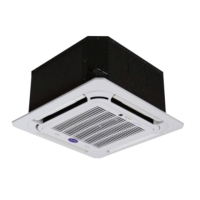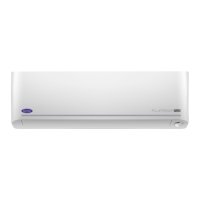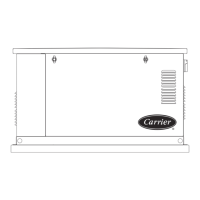Do you have a question about the Carrier 38VF012H117010 and is the answer not in the manual?
Covers product features including high efficiency, flexible design, and enhanced comfort.
Details the high energy efficiency achieved through DC inverter compressors and fan motors.
Covers convenient features for installation and service like auto addressing and super wiring.
Outlines the step-by-step procedure for selecting models based on load and system requirements.
Guides the selection of indoor units based on capacity tables and conditions.
Details the procedure for unit selection based on cooling load requirements.
Guides the selection of indoor units based on provided capacity tables.
Explains the process of selecting outdoor units based on combination ratios.
Provides detailed specifications for the independent units.
Details the electrical specifications, including current values and voltage ranges.
Provides wiring diagrams for different models and guidelines for field wiring.
Provides an introduction to installation, focusing on refrigerant piping selection.
Details the permitted lengths and level differences for refrigerant piping.
Specifies permitted lengths and level differences for refrigerant piping.
Guides the selection of pipes based on total capacity, length, and diameter.
Outlines the overall procedure for installing the air conditioning system.
Provides a general step-by-step procedure for installation tasks.
Details the specific procedure for installing indoor units.
Outlines the step-by-step procedure for installing refrigerant pipes.
Details the procedure for installing drainage pipes.
Provides guidelines for proper electrical wiring of the system.
Describes the procedure for applying heat insulation to pipes and equipment.
Provides instructions and cautions for installing the outdoor unit.
Details the procedure for recharging refrigerant, including calculations.
Lists key checks and preparations before commissioning and trial running.
Covers essential preparation steps before starting the installation.
Covers the installation procedures for both indoor and outdoor units.
Details the procedure and cautions for installing indoor units.
Covers the procedures for receiving, unpacking, hoisting, and positioning outdoor units.
Covers all aspects of refrigerant piping, including processing, storage, and installation.
Details the requirements and procedures for processing refrigerant pipes.
Outlines basic requirements for refrigerant pipe processing and installation.
Details the processing steps for copper pipes, including cutting and rectification.
Covers the process of brazing welding for refrigerant pipes.
Details methods for cleaning refrigerant pipes after installation.
Covers the purpose, procedure, and observation of air tightness tests.
Explains the purpose, methods, and procedures for vacuum drying the system.
Provides procedures for calculating and recharging refrigerant for the system.
Details the operational procedures, purpose, materials, and thickness for refrigerant pipe insulation.
Covers wiring instructions, power supply installation, and electric characteristics.
Covers pre-commissioning checks, preparation, and trial run procedures.
Details inspection and preparation steps required before commissioning.
Lists various error codes, their content, and corresponding notes for troubleshooting.
Provides diagnostic flowcharts and solutions for common system errors.
Troubleshooting steps for communication errors between outdoor units.
Troubleshooting steps for communication errors between indoor and master units.
Troubleshooting steps for ambient temperature sensor errors.
Troubleshooting steps for voltage errors affecting unit operation.
Troubleshooting steps for discharge temperature sensor errors.
Troubleshooting steps for errors related to incorrect outdoor unit addresses.
Troubleshooting for communication errors between DSP and main chip, or 0537 and main chip.
Troubleshooting for errors related to outdoor unit quantity changes.
Troubleshooting steps for errors indicating a decrease in indoor unit quantity.
Troubleshooting for high temperature protection of the inverter compressor.
Troubleshooting steps for high pressure protection in the system.
Troubleshooting steps for low pressure protection in the system.
Troubleshooting steps for compressor current protection errors.
Troubleshooting steps for condenser temperature protection errors.
Troubleshooting for inverter module protection errors.
Troubleshooting steps for xL0, xL8, and xL9 errors related to modular and compressor issues.
Troubleshooting steps for xL1 and xL4 errors related to power supply and rectifier circuits.
Troubleshooting steps for xL2 errors related to PCB voltage checks.
Troubleshooting steps for fan module protection errors.












